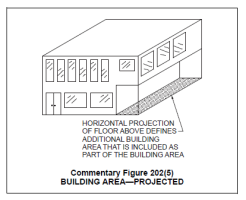rosegamble
REGISTERED
Hello, All. I have a somewhat basic question about the 2021 SC BC.
I am looking for some clarification on the definitions portion of the code.
Area, Building (from the official commentary)...
"Allowable building areas (as established by the provisions
of Chapter 5 and Table 506.2) are a function of
the potential fire hazard and the level of fire endurance
of the building’s structural elements, as established
for the types of construction in Chapter 6. A
building area is the “footprint” of the building; that is,
the area measured within the perimeter formed by the
inside surface of the exterior walls."
"Building Area" therefore does NOT include the thickness of the exterior walls. It is measured to the inside face.
However, then there is "Fire Area," which is defined as "the aggregate floor area enclosed and bounded by... exterior walls." So does fire area include exterior wall thickness while building area does not? Are you all including the exterior wall thickness in your "Fire Area" measurements?
Thanks!
I am looking for some clarification on the definitions portion of the code.
Area, Building (from the official commentary)...
"Allowable building areas (as established by the provisions
of Chapter 5 and Table 506.2) are a function of
the potential fire hazard and the level of fire endurance
of the building’s structural elements, as established
for the types of construction in Chapter 6. A
building area is the “footprint” of the building; that is,
the area measured within the perimeter formed by the
inside surface of the exterior walls."
"Building Area" therefore does NOT include the thickness of the exterior walls. It is measured to the inside face.
However, then there is "Fire Area," which is defined as "the aggregate floor area enclosed and bounded by... exterior walls." So does fire area include exterior wall thickness while building area does not? Are you all including the exterior wall thickness in your "Fire Area" measurements?
Thanks!


